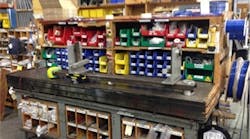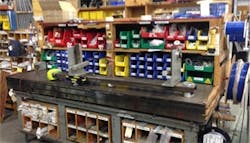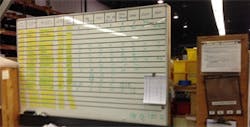Reducing waste, implementing efficiency-promoting practices, and continuously improving manufacturing operations are the main goals of Lean manufacturing. While these tasks may seem daunting for a manufacturer at the start of an improvement program, there are many concrete steps that can be taken to shift the culture at any company. For many companies, all it takes to dramatically increase efficiency and reduce waste is a commitment to dive right in and a willingness to continue trying new and creative ideas to find out what works best.
If you are able to simplify your manufacturing tasks, increase spatial and workflow organization, take steps to reduce errors, and listen to employees on the manufacturing floor, your company will begin to see reduced waste, improved employee morale and training, improved efficiency, and a greater ability to manufacture products on a predictable timetable.
Consider cellular manufacturing to simplify tasks
At the heart of waste reduction and increased efficiency is simplifying the processes related to each manufacturing task. Without a critical eye towards opportunities for simplification, manufacturing tasks can grow inefficient and lead to wasted time, wasted resources, and inconsistent product quality. Finding an appropriate method for simplifying manufacturing tasks is, therefore, an important first step in any company’s improvement.
One practice that can help is cellular manufacturing. With this method, cells are set up on the manufacturing floor, one for each different component of the final product and step in the manufacturing process (Figure 1). The individual cells are tailored to their function in terms of materials, tools, and design. In this way, efficiency is increased and waste reduced because all of the appropriate materials and tools are already at workers’ fingertips.
Cellular manufacturing also calls for the same process to be followed each time a certain part is produced or altered. Possible errors are reduced by this increased repetition and operator training is made simpler. Perhaps most important to the Lean manufacturing process, repetition makes it easier to make iterative changes and track whether these changes have a positive effect on the overall efficiency of the process.
Though cellular manufacturing is not the only way to simplify manufacturing operations, it is one of the most effective, and provides an excellent example for the positive outcomes that can result from implementing Lean practices. Cellular manufacturing may be right for your business, or you may want to try to find a different way to simplify tasks. Either way, finding a way to simplify your manufacturing process that leads to repeatable quality and easily traceable results is an important first step in the journey of improving your manufacturing practices.
Increase organization
In addition to simplifying your process, organizing your manufacturing floor and workflow can have a great impact on increasing efficiency. Spatial organization of tools, materials, and manufacturing space cuts down on search and transport times, while neat and orderly workspaces help workers to feel more relaxed and able to work quickly and efficiently. General cleanliness from dirt, dust, spills and more is important, not just because of its positive impact on worker morale but also because it helps to improve safety of workers and final product quality. Cleanliness is fairly easy to maintain if cleaning supplies are easily visible and readily available. Organization, on the other hand, usually requires a more codified system.
Visual systems are particularly useful when it comes to manufacturing organization. For example, job boards directly on the manufacturing floor help to convey instructions and customer needs directly to those who need them (Figure 2). These boards can include what jobs are currently on the manufacturing floor and their status, instructions, or any other relevant information for managers, operators, and other staff. Similarly, job books can include more detail about each individual product and can be made accessible to all workers who need access to the information.
With these two systems as an example, you can see how organization can help ensure that everyone is working from the same information; when everything has its own place, and everything in its place has a purpose, all forms of waste are drastically reduced.
Take steps to reduce errors
All of the steps that are taken to improve organization can help in the prevention of errors in the manufacturing process. Errors are, of course, an inevitable part of manufacturing, regardless of the level of automation, organization, and simplicity in the system. Recognizing common sources of errors beyond organizational issues and working to improve them can help to limit those errors, and therefore positively impact your process.
For instance, the number of times a part or product is handled often leads to an increase in the likelihood that an error occurs. Conversely, limiting a part or product’s handling time will decrease the chance that an error will occur. Taking steps to limit material handling is, then, one way of promoting error reduction in your process.
One way to reduce material handling is to introduce a vendor-managed inventory (VMI) process. Though some may think that VMI simply increases the likelihood that errors will occur on the part of vendors, in reality, VMI is much more than shifting responsibility and handling time. VMI helps to reduce the total inventory in the system and reduce each individual component’s amount of handling by essentially extending the vendor’s factory or warehouse into your own manufacturing facility. The vendor places inventory right into manufacturing cells or other use areas, cutting out the need to receive, handle, count, and shift components from receiving to their point of storage and then point of use (Figure 3).
In addition, creating standard procedures whenever possible can help to reduce errors. Increased repetition means simpler operator training and increased familiarity with the process. Simplified operation and training has the added benefit of making it easier to train your workforce across different parts of the manufacturing process. Cross-trained workers help to increase workforce flexibility and therefore efficiency.
Listen to employees and constantly improve
Cross training workers throughout your manufacturing process has benefits beyond flexible work assignments, as well. Cross training gives employees a broader look at the entire manufacturing process, and makes it more likely that they will be able to come up with creative solutions for increasing efficiency and continuously improving your process. Continuous improvement, after all, cannot work when implemented as a top-down process, because executives and even managers often do not have the kind of hands-on experience with the process that is key to finding new and better ways of doing things. Workers throughout the process must feel free to think creatively about the work they and their peers are doing, and innovate ways to make that work more efficient with greater quality control.
Employee empowerment and buy-in to a continuous improvement process occurs in something of a positive feedback loop, as well. When employees see their own or their co-workers’ ideas being implemented, they become more likely to speak up when they have an idea. This is especially true when ideas are encouraged and those who attempt to innovate are not stifled if their ideas don’t end up working.
One of the most important things to recognize about implementing Lean manufacturing practices is that not every step in a continuous improvement process will, in fact, improve your process. Some ideas will be tested and not work well, and you shouldn’t be afraid to take a step backwards and start over when something doesn’t work the way you imagine it will. You can always take a step back, but unless all employees feel that their ideas are valued, you won’t always be able to take interesting, creative steps forward.
Overall benefits of Lean manufacturing
Successful Lean manufacturing initiatives, as implemented with these tips in mind, lead to a wealth of benefits. Some of the many benefits of Lean manufacturing practices include: increased efficiency, higher throughput, more predictable timing of the manufacturing process, and therefore a greater ability to forecast production schedules and meet product deliveries. Butler Automatic, for example, has had a Lean outlook on manufacturing for many years, but took great strides forward in simplifying and improving their process in 2014. As a result, on-time delivery improved from an average of 77% before 2014 to 97% in 2014 alone. For Butler Automatic, whose products are one part of large packaging lines, on-time production is critical, and Lean manufacturing practices have led to huge strides forward in this area.
In addition, the practices described in this article lead to a better-trained, more flexible workforce. That training, combined with a more pleasant work environment and an encouragement of new and creative ideas on the part of employees, leads to a happier, more productive, and more loyal staff. With a group of people who take great pride in their work and who enjoy doing it, continuous improvement is a natural, long-lasting result, and a way of life at your company.




